2016-2017年对外经济贸易大学831会计学专业考研专业英语复习笔记4—新祥旭考研辅导
会计专业英语复习资料.doc
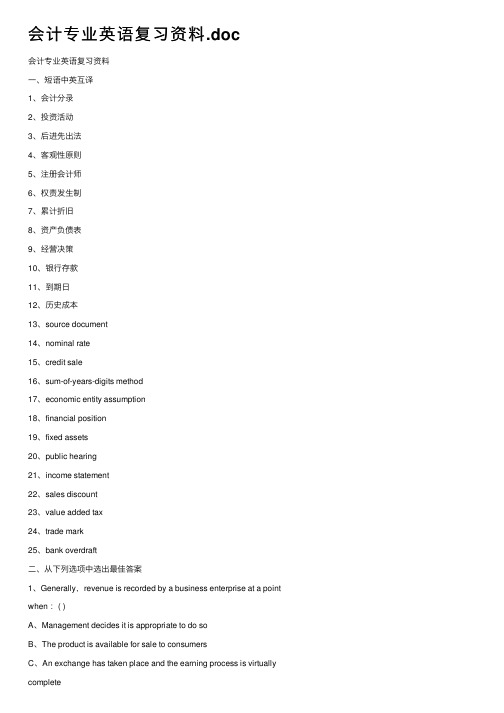
会计专业英语复习资料.doc会计专业英语复习资料⼀、短语中英互译1、会计分录2、投资活动3、后进先出法4、客观性原则5、注册会计师6、权责发⽣制7、累计折旧8、资产负债表9、经营决策10、银⾏存款11、到期⽇12、历史成本13、source document14、nominal rate15、credit sale16、sum-of-years-digits method17、economic entity assumption18、financial position19、fixed assets20、public hearing21、income statement22、sales discount23、value added tax24、trade mark25、bank overdraft⼆、从下列选项中选出最佳答案1、Generally,revenue is recorded by a business enterprise at a point when :( )A、Management decides it is appropriate to do soB、The product is available for sale to consumersC、An exchange has taken place and the earning process is virtually completeD、An order for merchandise has been received2、Why are certain costs capitalized when incurred and then depreciated or amortized over subsequent accounting periods?( )A、To reduce the income tax liabilityB、To aid management in making business decisionsC、To match the costs of production with revenue as earnedD、To adhere to the accounting concept of conservatism3、What accounting principle or concept justifies the use of accruals and deferrals?( )A、Going concernB、MaterialityC、ConsistencyD、Stable monetary unit4、An accrued expense can best be described as an amount ( )A、Paid and currently matched with revenueB、Paid and not currently matched with revenueC、Not paid and not currently matched with revenueD、Not paid and currently matched with revenue5、Continuation of a business enterprise in the absence of contrary evidence is an example of the principle or concept of ( )A、Business entityB、ConsistencyC、Going concernD、Substance over form6、In preparing a bank reconciliation,the amount of checks outstanding would be:( )A、added to the bank balance according to the bank statement.B、deducted from the bank balance according to the bank statement.C、added to the cash balance according to the depositor’s records.D、deducted from the cash balance according to the depositor’s records.7、Journal entries based on the bank reconciliation are required for:( )A、additions to the cash balance according to the depositor’s records.B、deductions from the cash balance according to the depositor’srecords.C、Both A and BD、Neither A nor B8、A petty cash fund is :( )A、used to pay relatively small amounts。
2016-2017年对外经济贸易大学831会计学综合《资产质量分析》讲义—新祥旭考研辅导

第二章资产质量分析(重点)第1节资产负债表的作用1.会计计量属性1)历史成本01、03、07、08年名词解释问答题中均考察过。
采用历史成本原则计价的优越性在于:第一,由于交易的价格是由企业与企业外部共同确定的,因而具有一定的客观性;第二,历史成本的确定通常有一定的会计凭证作依据,具有可验证性;第三,历史成本原则还可以抑制因主观判断而产生的可能蓄意歪曲企业财务状况的事件发生。
2)重置成本在重置成本计量下,资产按照当前市场条件,重新取得同样一项资产所需支付的现金或者现金等价物金额计量。
负债按照现在偿还该项债务所需支付的现金护着现金等价物的金额计量。
3)可变现净值在可变现净值剂量下,资产按照其正常对外销售所能收到的现金或者现金等价物的金额扣减该资产至完工时估计将要发生的成本、估计的销售费用以及相关税费后的金额计量。
4)现值在现值计量下,资产按照预计从其持续使用和最终处置中所产生的未来净现金流入量的折现金额计量。
负债按照预计期限内需要偿还的未来净现金流出量的折现金额计量。
5)公允价值08年问答题在公允价值计量下,资产和负债按照在公平交易中,熟悉情况的交易双方自愿进行资产交换或者债务清偿的金额计量。
在实务中,一般应当采用历史成本。
采用重置成本、可变现净值、现值、公允价值计量的,应当保证所确定的资产金额能够取得并可靠计量。
考虑到中国市场发展的现状,新准则体系中主要在金融工具、投资性房地产、非共同控制下的企业合并、债务重复、非货币性交易等方面采用了公允价值。
总体上,新会计准则体系对公允价值的运用还是比较谨慎的,但无论如何,历史成本已不再作为一项会计核算的基本原则。
2.企业资产负债表的作用如何?1)资产负债表揭示了企业拥有或控制的能用货币表现的经济资源即资产的总规模及具体的分布形态。
2)把流动资产、速动资产与流动负债联系起来分析,可以评价企业的短期偿债能力。
3)通过对企业债务规模、债务结构与所有者权益的对比,可以对企业的长期偿债能力及举债能力(潜力)做出评价。
2016贸大金融硕士真题及815经济学综合考研资料整合
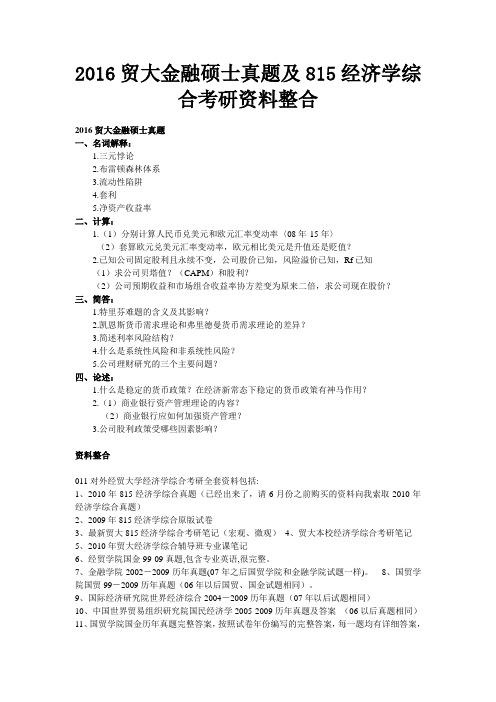
2016贸大金融硕士真题及815经济学综合考研资料整合2016贸大金融硕士真题一、名词解释:1.三元悖论2.布雷顿森林体系3.流动性陷阱4.套利5.净资产收益率二、计算:1.(1)分别计算人民币兑美元和欧元汇率变动率〈08年-15年〉(2)套算欧元兑美元汇率变动率,欧元相比美元是升值还是贬值?2.已知公司固定股利且永续不变,公司股价已知,风险溢价已知,Rf已知(1)求公司贝塔值?(CAPM)和股利?(2)公司预期收益和市场组合收益率协方差变为原来二倍,求公司现在股价?三、简答:1.特里芬难题的含义及其影响?2.凯恩斯货币需求理论和弗里德曼货币需求理论的差异?3.简述利率风险结构?4.什么是系统性风险和非系统性风险?5.公司理财研究的三个主要问题?四、论述:1.什么是稳定的货币政策?在经济新常态下稳定的货币政策有神马作用?2.(1)商业银行资产管理理论的内容?(2)商业银行应如何加强资产管理?3.公司股利政策受哪些因素影响?资料整合011对外经贸大学经济学综合考研全套资料包括:1、2010年815经济学综合真题(已经出来了,请6月份之前购买的资料向我索取2010年经济学综合真题)2、2009年815经济学综合原版试卷3、最新贸大815经济学综合考研笔记(宏观、微观)4、贸大本校经济学综合考研笔记5、2010年贸大经济学综合辅导班专业课笔记6、经贸学院国金99-09真题,包含专业英语,很完整。
7、金融学院2002-2009历年真题(07年之后国贸学院和金融学院试题一样)。
8、国贸学院国贸99-2009历年真题(06年以后国贸、国金试题相同)。
9、国际经济研究院世界经济综合2004-2009历年真题(07年以后试题相同)10、中国世界贸易组织研究院国民经济学2005-2009历年真题及答案(06以后真题相同)11、国贸学院国金历年真题完整答案,按照试卷年份编写的完整答案,每一题均有详细答案,包含专英答案,另有答题技巧,并概括归纳了考点。
会计笔记英语知识点归纳

会计笔记英语知识点归纳会计是一门与经济紧密相关的学科,对于学习和从事会计工作的人来说,掌握好会计笔记的英语知识点非常重要。
本文将归纳一些常见的会计笔记英语知识点,帮助读者更好地理解和运用这些概念。
1. Financial Statements(财务报表)Financial statements are crucial in accounting as they provide a comprehensive summary of a company's financial activities. The four main types of financial statements are: balance sheet, income statement, cash flow statement, and statement of changes in equity.财务报表在会计中非常重要,因为它们提供了一个公司财务活动的综合概述。
财务报表有四种主要类型:资产负债表、损益表、现金流量表和股东权益变动表。
2. Double-Entry Bookkeeping(复式记账法)Double-entry bookkeeping is a fundamental concept in accounting.It states that every financial transaction has equal and opposite effectson at least two accounts. This ensures that the accounting equation (assets = liabilities + equity) remains balanced.复式记账法是会计中的一个基本概念。
它指出每一笔财务交易对至少两个账户产生相等且相反的影响。
这样可以确保会计方程式(资产=负债+所有者权益)保持平衡。
对外经贸会计学硕专业课831会计学综合

文章标题:深度解析外经贸会计学硕专业课831会计学综合一、引言在当今全球化经济环境下,外经贸会计学硕专业课831会计学综合作为会计专业的核心课程,扮演着至关重要的角色。
本文将对该专业课进行深度探讨,以期为读者提供全面而有价值的了解。
二、概述831会计学综合是外经贸会计学硕专业课中的重要一环。
该课程旨在帮助学生全面掌握会计学的基本理论、知识和技能,并能够灵活运用于实际工作中。
学习本课程将有助于拓宽学生的学术视野,提高其会计实务能力,为其未来的职业发展奠定坚实基础。
三、课程内容1. 会计学基本理论831会计学综合首先介绍了会计学的基本理论,包括会计信息系统、会计伦理、会计准则等内容。
通过对这些理论的学习,学生将能够建立起对会计学的整体认识,为后续学习和实践提供理论支持。
2. 会计学基本知识在基本理论的基础上,本课程还囊括了会计学的基本知识,如会计要素、会计科目、会计核算等。
这些知识的系统学习将有助于学生深入了解会计学的实质,为日后的实际操作打下坚实基础。
3. 会计学实务技能除了理论和知识,831会计学综合还注重培养学生的会计实务技能。
课程安排了大量的实际案例分析和财务报表分析,帮助学生掌握会计实务操作的要点,增强其解决实际问题的能力。
四、个人观点与理解作为一名从业多年的会计师,我深知831会计学综合的重要性。
这门课程不仅让我在理论上对会计学有了更深入的认识,也为我日常工作中的实务操作提供了宝贵的指导。
通过系统学习这门课程,我不仅能够熟练掌握会计核算技能,还能够在财务报表分析中游刃有余,为公司的经营决策提供关键支持。
五、总结与回顾通过本文的探讨,相信读者已经对外经贸会计学硕专业课831会计学综合有了更深入的了解。
这门课程对于学生来说至关重要,它不仅能够拓宽学术视野,提高实务操作能力,还为未来职业发展奠定坚实基础。
831会计学综合是一门富有深度和广度的专业课程,它的学习将会为学生的人生和职业带来巨大的收益。
2016-2017年对外经济贸易大学831会计学综合《资本结构质量分析》讲义—新祥旭考研辅导

第三章资本结构质量分析(重点)1.负债:是指企业在某一特定日期承担的,过去的交易或事项形成的预期导致经济利益流出企业的现时义务。
2.流动负债质量分析:流动资产是一年以内可变现的资产项目,流动负债为一年内应清偿的债务责任。
任一时点,两者的数量对比对企业的短期经营活动均产生十分重要的影响:1)流动负债周转分析。
流动性差的短期负债会在无形中降低企业的流动风险,如果不对流动负债各部分按流动性进行区分与分析,往往会高估企业的流动性风险。
2)非强制性流动负债分析。
对于企业短期偿债能力来说,能够真正影响企业显示偿债能力的是那些强制性债务。
对于预收款项,部分应付张狂,其他应付款鞥,由于某些因素的影响,不必当期偿付,实际上并不构成对企业短期付款的压力,属于非强制性债务。
3)企业短期贷款规模可能包含的融资质量信息4)企业应付票据与应付账款的数量变化包含的经营质量信息。
5)企业税金缴纳情况与税务环境。
如果企业的应交所得税递延所得税负债表现为增加的态势,表明在纳税方面有可以允许企业推迟缴纳税款的相对有利的税务环境。
3.预计负债:反映企业确认的对外提供担保、未决诉讼、产品质量保证、亏损性合同、重组义务等很可能产生的负债,如果与或有事项有关的义务同时符合以下条件,企业应将其确认为负债,并在资产负债表上以预计负债单独反映:第一,该义务是企业承担的现时义务;第二,该义务的履行很可能导致经济利益流出企业;第三,该义务的金额能可靠地计量。
其中“很可能”指发生的可能性为“>50%<=95%”4.非流动负债质量分析1)企业非流动负债所形成的固定资产、无形资产的利用状况与增量效益。
企业非流动负债形成的固定资产无形资产必须得到充分利用;企业非流动负债形成的固定资产无形资产必须产生增量效益。
2)企业非流动负债所形成的长期股权投资的效益及其质量。
长期股权投资必须产生投资收益,且投资收益对应相当规模的货币回收。
3)企业非流动负债所对应的流动资产与质量。
贸大复习提纲-会计学原理

对外经济贸易大学远程教育学院2016-2017学年第二学期《会计学原理》复习大纲一、单选题1. 会计主体假设明确了会计工作的()。
A. 时间范围B. 监督范围C. 空间范围D. 核算范围2. 外部信息使用者了解单位会计信息最主要的途径是()。
A. 财务报告B. 财产清查C. 会计账薄D. 企业管理者的行为3. 下列各项会计信息质量要求中,对相关性和可靠性起着制约作用的是()。
A. 及时性B. 谨慎性C. 重要性D. 实质重于形式4. 某企业期初负债总额为80000元,所有者权益总额为100000元。
现收回外单位前欠货款20000元,则此时企业的资产总额为()。
A. 2000000元B. 40000元C. 180000元D. 160000元5. 用银行存款偿还短期借款,会引起()。
A. 负债总额不变B. 费用增加C. 资产总额不变D. 所有者权益总额不变6. 下列项目中,能同时影响资产和负债发生变化的是()。
A. 接受投资者投入设备B. 支付现金股利C. 支付股票股利D. 收回应收账款7. 下列各项不属于反映“会计信息质量要求”的是()。
A. 可靠性B. 可比性C. 实质重于形式D. 历史成本8. 会计科目是()的名称。
A. 会计要素B. 会计账户C. 会计账簿D. 会计对象9. 开设明细分类账户的依据是()。
A. 总分类科目B. 试算平衡表C. 明细分类科目D. 会计要素内容10. 与总分类账户存在对应关系的账户是()。
A. 一级账户B. 对应账户C. 明细分类账户D. 要素账户11. 会计科目是对()A. 经济业务分类形成的项目B. 会计要素具体内容分类形成的项目C. 会计账户分类形成的项目D. 会计方法分类形成的项目12. 下列会计科目中属于资产类会计科目的是()A. 应付账款B. 短期借款C. 应付债券D. 应收账款13. 账户的基本结构包括()A. 账户的具体格式B. 账户登记的经济内容C. 账户登记的日期D. 账户中登记增减金额及余额14. 下列会计科目中属于负债类会计科目的是()A. 应付账款B. 固定资产C. 实收资本D. 应收账款15. 企业在任何时日其资产总额一定等于()。
2017年对外经济贸易大学831会计学综合考研专业英语讲义13—新祥旭考研辅导

Chapter10LiabilitiesCollateral:assets that have been pledged to secure specific liabilities.Creditors with secured claims can foreclose on these assets if the borrower defaultsEstimated liabilities:liabilities known to exist,but that must be recorded in the accounting records at estimated dollar amounts.Current liabilitiesAccrued liabilities arise from the recognition of expense for which payment will be made in a future period.Thus accrued liabilities also are called accrued expenses.Examples of accrued liabilities include interest payable,income payable,income taxes payable,and a number of liabilities relating to payrolls.Long-term liabilitiesMaturing obligations intended to be refinancedIf management has both the intent and the ability to refinance soon-to-mature obligations on a long-term basis,these obligations are classified as long-term liabilities.In this situation,the accountant looks more to the economic substance of the situation rather than to its legal form. When the economic substance of a transaction differs from its legal form or its outward appearance,financial statements should reflect the economic substance.Accountants summarize this concept with the phrase“substance takes precedence over form”Amortization table:a schedule that indicates how installment payments are allocated between interest expense and repayment of principal.Bonds payable(非常重要的内容)Bonds payable:long-term debt securities that subdivide a very large and long-term corporate debt into transferable increments of$1000or multiples thereof.The principal advantage of issuing bonds instead of capital stock is that interest payments to bondholders are deductible in determining taxable income,whereas dividends payments to stockholders are not.Sinking fund:cash set aside by a corporation at regular intervals(usually with a trustee)for the purpose of repaying a bond issue at its maturity date.Convertible bond(10年名詞):a bond that may be exchanged(at the bondholder’s option)for a specified number of shares of the company’s capital stock.Junk bond:bonds payable that involve a greater than normal risk of default and,therefore,must pay higher than normal rates of interest in order to be attractive to investors.Changes in the current level of interest are not the only factors that influencing the market prices of bonds.The length of time remaining until the bonds mature is another major force.As a bond nears its maturity date,its market price normally moves closer and closer to the maturity value.This trend is dependable because the bonds are redeemed at face value on the maturity date.(05年汉译英)Remember that,after bonds have been issued,they belong to the bondholder,not to the issuing corporation.Therefore,changes in the market price of bonds subsequent to their issuance do not affect the amounts shown in the financial statements of the issuing corporation,and these changes are not recorded in the company’s accounting records.Estimated liabilities,loss contingencies,and commitmentsEstimated liabilities(2011年名词解释)The term estimated liabilities refers to liabilities that appear in financial statements at estimated dollar amounts.Estimated liabilities involve some degree of uncertainty.However,(1)the liabilities are known to exist,and(2)the uncertainty as to dollar amount is not so great as to prevent the company from making a reasonable estimate and recording the liability.Loss contingenciesSituations involving uncertainty as to whether a loss has occurred.The uncertainty will be resolved by a future event.An example of a loss contingency is the possible loss relating to a lawsuit pending against a company.Although loss contingencies are sometimes recorded in the accounts,they are more frequently disclosed only in notes to the financial statements.Loss contingencies are recorded in the accounting records only when both of the following criteria are met(1)it is probable that a loss has been incurred,and(2)the amount of loss can be reasonably estimated.When these criteria are not met,loss contingencies are disclosed in notes to the financial statements if there is a reasonable possibility that a material loss has been incurred Loss contingencies differ from estimated liabilities in two ways.First,a loss contingency may involve a greater degree of uncertainty.Often the uncertainty extends to whether any loss or expense actually has been incurred.In contrast,the loss or expense relating to an estimate liability is known to exist.Second,the concept of a loss contingency extends not only to possible liabilities,but also to possible impairments of assets.Commitments:agreements to carry out future transactions.although they are not a liability(because the transaction has not yet been performed),they may be disclosed in notes to the financial statements.Evaluating the Safety of Creditors’ClaimsDebt ratio负债比率=Total Liabilities/total assetsInterest coverage ratio利息保障比率or Times interest earned利息保障倍数=operating income/annual interest expense.Indicating the number of times that the company was able to earn the amount of its interest charges.Leverage:using borrowing money to finance business operations is called applying~The effect of leverage may be summarized as follows:ROA>interest rates being paid net income/ROE increaseROA<nterest rates being paid net income/ROE decreaseFinancial analysis and decision makingShort-term:Quick ratio.Current ratio Working capital Turnover rates Operating cycle Net cash flows from operating activities Lines of credit.Long-term:Debt ratio interest coverage ratio Trend in net cash flows from operating activities. Trend in net incomeDeferred income taxes:A liability account to pay income taxes that have been postponed to a future year’s income tax return.In some cases,this account can also be an asset account representing income taxes to be saved in a future year’s income tax return.Present value:(of a future amount):the amount of money that an informed investor would pay today for the right to receive the future amount,based on a specific rate of return required by the investor.Summary of learning objectivesLog6.Account for bonds issued at a discount or premium:Log8.Explain how estimated liabilities,loss contingencies,and commitments are disclosed in financial statements.。
2016-2017年对外经济贸易大学831会计学综合《所有者权益变动分析》讲义—新祥旭考研辅导

第四章利润质量与所有者权益变动表分析(重点)1.企业利润表的基本内容和具体结构如何?答:利润表也称为收益表,是总括地反映企业一定期间内经营成果的会计报表。
与资产负债表不同,利润表是一种动态的时期报表,主要揭示了企业一定时期的收入实现情况、费用耗费情况、以及由此计算出的利润情况。
利润表的列报必须充分反映企业经营业绩的主要来源和构成,有助于使用者判断净利润的质量及其风险,有助于使用者预测净利润的持续性,从而做出正确决策。
利润表一般由表首、表身和补充资料三部分构成。
表首主要填制编制单位、报表日期、货币单位等。
表身是利润表的主体部分,主要反映收入、费用和利润各项目的具体内容及其相互关系。
(120)利润的质量是什么2.全面收益观:一个主体在其某一期间与非业主方面进行交易或者发生其他事项和情况所引起的权益变动。
它包括这一期间内除业主投资和派给业主款以外的产权的一切变动。
全面收益=净收益+其他全面收益。
其中净收益是传统意义下的税后利润,其他全面收益是除净收益以外在各个会计期间内的其他非业主交易引起的权益变动。
3.利得和损失:可以分为直接计入当期利润的利得和损失,以及直接计入所有者权益的利得和损失。
4.收入:是指企业在日常活动中形成的、会导致所有者权益增加的、与所有者投入资本无关的经济利益的总流入。
主要包括销售商品、提供劳务、和让渡资产使用权收入。
企业代第三方收取的款项,应当作为负债处理,不应当确认为收入。
5.我国关于收入的会计准则对收入的确认和计量是如何规定的?答:(1)销售商品收入同时满足下列条件的,才能予以确认:①企业已将商品所有权上的主要风险和报酬转移给购货方;②企业既没有保留通常与所有权相联系的继续管理权,也没有对已出售的商品实施有效控制;③收入的金额能够可靠地计量。
④相关的经济利益很可能流入企业;⑤相关的已发生或发生的成本能够可靠地计量。
(2)Ⅰ企业在资产负债表日提供劳务交易的结果能够可靠估计的,应当采用完工百分比法确认提供劳务收入。
对外经贸大学会计专业中英文试题
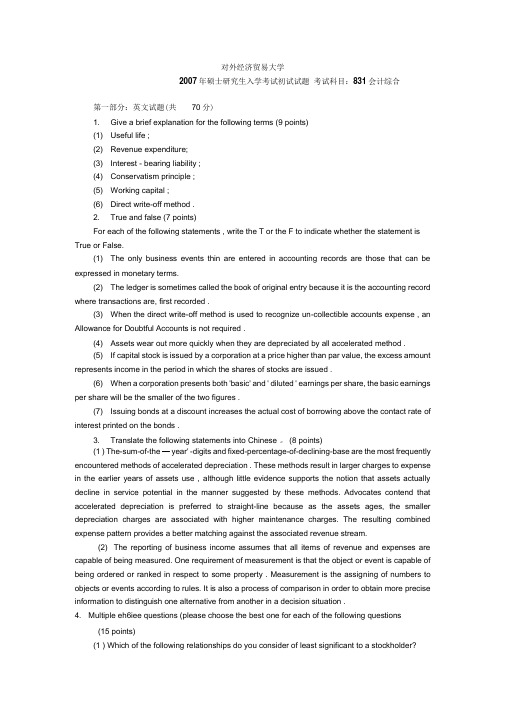
对外经济贸易大学2007年硕士研究生入学考试初试试题考试科目:831会计综合第一部分:英文试题(共70分)1. Give a brief explanation for the following terms (9 points)(1) Useful life ;(2) Revenue expenditure;(3) Interest - bearing liability ;(4) Conservatism principle ;(5) Working capital ;(6) Direct write-off method .2. True and false (7 points)For each of the following statements , write the T or the F to indicate whether the statement is True or False.(1) The only business events thin are entered in accounting records are those that can be expressed in monetary terms.(2) The ledger is sometimes called the book of original entry because it is the accounting record where transactions are, first recorded .(3) When the direct write-off method is used to recognize un-collectible accounts expense , an Allowance for Doubtful Accounts is not required .(4) Assets wear out more quickly when they are depreciated by all accelerated method .(5) If capital stock is issued by a corporation at a price higher than par value, the excess amount represents income in the period in which the shares of stocks are issued .(6) When a corporation presents both 'basic' and ' diluted ' earnings per share, the basic earnings per share will be the smaller of the two figures .(7) Issuing bonds at a discount increases the actual cost of borrowing above the contact rate of interest printed on the bonds .3. Translate the following statements into Chinese 。
对外经济贸易大学国际商学院831会计学综合历年考研真题

2001年对外经济贸易大学会计学综合考研真题(含答案)对外经济贸易大学2001年攻读硕士学位研究生入学考试会计综合试题一、解释下列名词或术语(每小题2.5分,共15分)1.完全成本法2.损益平衡点(保本点)3.会计主体假设4.稳健性原则5.货币的时间价值6.现金等价物二、填空题(每空1分,共10分)1.净资产收益率是指与之间的比率,衡量企业的能力。
2.中国最新修订的《会计法》的实施时间是2000年7月1日。
3.关联方是指。
4.上市公司是每股收益是指与的比率。
5.企业要向股东分派现金股利,除了其可供分配的利润规模足够大以外,企业还要有足够的能力。
三、问题答题(每题15分,共45分)1.最近,我国某著名企业家说出了这样一句话:企业资不抵债不一定破产清算,企业没有现金流量就一定会破产清算。
请从企业资不抵债的含义、资不抵债的可能原因、没有现金流量对企业经营活动的影响等方面对上述说法进行评论。
2.如何进行多种产品的本量利分析?品种结构发生变化对多种产品的本量利分析有何影响?请自行高例通过计算说明(用两种产品来说明)。
3.请说明历史成本原则、客观性原则的基本含义及基对报表使用者认识财务信息的影响。
四、综合题(共30分)不论是财务管理,还是成本会计、管理会计,均将预算控制作为重要的管理手段。
请回答下列问题:1.预算控制的主要内容;2.成本会计的哪些方面体现了预算控制的思想?3.静态预算的主要特点有哪些?4.为什么说弹性预算是一种较好的预算管理方法?5.除了弹性预算以外,还有哪些较先进的预算管理方法?其含义如何?答案部分对外经济贸易大学2001年攻读硕士学位研究生入学考试会计综合试题一、解释下列名词或术语(每小题2.5分,共15分)1.完全成本法: 也即全部成本法,是传统的成本计算方法,其特点是在计算产品成本和存货成本时,把生产过程中所消耗的直接材料、直接人工、变动制造费用和固定制造费用等全部生产成本都包括在内,而将非生产成本作为期间成本。
外经济贸易大学远程教育学院 2016-2017 学年第一学期 《财务会计》复习大纲

为 5 年。在采用双倍余额递减法计提折旧的情况下,该项设备第二年应计提折旧额
(
)万元。
A. 48
B. 80
C. 51
D. 38
50.期末结转后没有余额的账户类型是(
)。
A. 资产类账户
B. 损益类账户
C. 负债类账户
D. 所有者权益类账户
51.在借贷记账法下,资产类账户的期末余额等于(
金领计量,是基于(
)计量属性。
A. 历史成本
B. 可变现净值
C. 公允价值
D. 现值
15.按照我国企业会计准则的要求,销售商品涉及现金折扣的,销售方应在现金折扣实际发
生时(
)。
A. 冲减当期产品销售收入
B. 计入当期财务费用
C. 计入当期销售费用
D. 计入当期管理费用
16.对于销货方按销售合同、协议规定已经确认销售,而尚未发运给购货方的商品,应作为
)。
A. 银行汇票
B. 银行本票
C. 支票
D. 商业汇票
25.属于以公允价值计量且其变动计入当期损益的金融资产是(
)。
A. 持有至到期投资
B. 交易性金融资产
C. 可供出售金融资产
D. 贷款和应收款项
26.对于某客户的应收账款,当企业确认其确实无法收回并注销时,应编制的会计分录为
(
)。
A. 借记“资产减值损失”,贷记“应收账款”
D. 固定资产提足折旧后,不论能否继续使用,均不再计提折旧
13.无形资产在取得后的使用期间内,应以(
)进行后续计量。
A. 取得成本
B. 成本减去累计摊销额后的余额
C. 成本减去累计减值准备后的余额
D. 成本减去累计摊销额和累计减值准备后的余额
会计笔记英语知识点大全

会计笔记英语知识点大全会计是一门重要的商科学科,会计笔记是会计学习中的重要组成部分。
在学习会计的过程中,掌握会计笔记的英语知识点对于提高学习效果和职业发展都有很大帮助。
本文将为您介绍会计笔记英语知识点的大全,希望对广大会计从业人员和学生有所帮助。
一、基本会计概念的英语表达1. 会计 (Accounting)会计是一门记录、分类和分析财务信息的学科。
2. 账户 (Account)账户是用于记录和汇总相关财务信息的记录单元。
3. 资产 (Asset)资产是企业所拥有的可预期经济利益。
4. 负债 (Liability)负债是企业所欠他人的债务。
5. 所有者权益 (Equity)所有者权益是企业所拥有的资产减去负债后所剩余的权益。
6. 收入 (Revenue)收入是企业在销售商品或提供服务时所获得的经济利益。
7. 支出 (Expense)支出是企业为取得收入而发生的或与经营业务有关的费用。
二、会计科目的英语表达1. 资产科目 (Asset Accounts)资产科目包括现金、应收账款、存货、固定资产等。
2. 负债科目 (Liability Accounts)负债科目包括应付账款、长期负债等。
3. 所有者权益科目 (Equity Accounts)所有者权益科目包括股东投资、净利润等。
4. 收入科目 (Revenue Accounts)收入科目包括销售收入、服务收入等。
5. 支出科目 (Expense Accounts)支出科目包括工资支出、租金支出等。
三、会计凭证的英语表达1. 借方 (Debit)借方是会计凭证上记载“增加”或“支出”的一方。
2. 贷方 (Credit)贷方是会计凭证上记载“减少”或“收入”的一方。
3. 手工记账 (Manual Accounting)手工记账是指使用纸质或电子表格进行会计凭证录入的操作。
4. 自动记账 (Automated Accounting)自动记账是指使用会计软件或系统进行会计凭证录入的操作。
对外经贸大学831会计学综合考研真题—新祥旭考研辅导 .pdf
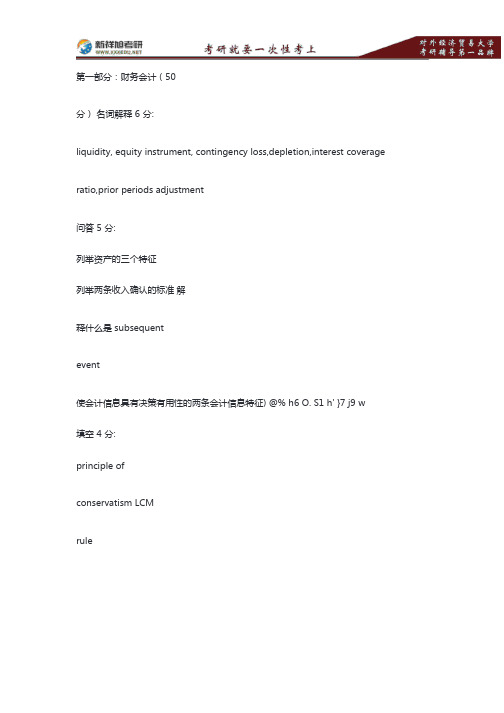
第一部分:财务会计(50分)名词解释 6 分:liquidity, equity instrument, contingency loss,depletion,interest coverage ratio,prior periods adjustment问答 5 分:列举资产的三个特征列举两条收入确认的标准解释什么是 subsequentevent使会计信息具有决策有用性的两条会计信息特征) @% h6 O. S1 h' }7 j9 w填空 4 分:principle ofconservatism LCMruleextraordinary items4 个还有一个记不清。
判断 8 个 8 分都是很基本的题目。
选择 8 个 8分有个题是课本原题关于流动比率下降而速动比率上升的,其他题目都挺新鲜的,没有以前的原题了。
汉译英 10 分第一个是关于折旧方法选择的,第二个是关于净收益理论和实体理论的一致性。
计算分析 9 分第一个是 Long term liabilities 的分析:为什么公司的信用评级提高而债券的现行市价低于面值;解释公司现行市价的降低如何影响利润表和资产负债表。
第二个是 Statement of cash flows 的计算:以前某一年的原题,计算土地和证券的账面价值。
没有考 EPS 的计算。
第二部分:管理会计(25 分)第一道是完全成本法和变动成本法的比较,给了在完全成本法下的损益表,以及一些库存数据、本月的固定制造费用,根据这些计算在变动成本法下的税前利润;解释造成完全成本法和变动成本法下税前利润不同的原因。
(15 分)第二道是约当产量法,没有告诉期初和本月投入的实物数量,只告诉了本月完工和月末产量,以及期初和本月投入的成本数额,据上述信息计算本月完工产品成本和月末在产品成本。
(10 分)第三部分:财务报表分析(40 分)第一道(8 分):存货周转率、毛利率、应收账款周转率的计算公式,以及各自的含义;举例说明这三者之间的联动关系(至少三种),以及各自对应的公司经营状态。
对外经贸会计学硕专业课831会计学综合
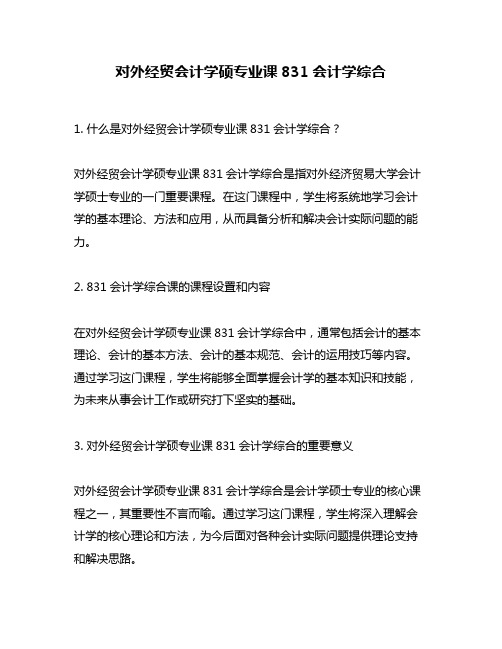
对外经贸会计学硕专业课831会计学综合1. 什么是对外经贸会计学硕专业课831会计学综合?对外经贸会计学硕专业课831会计学综合是指对外经济贸易大学会计学硕士专业的一门重要课程。
在这门课程中,学生将系统地学习会计学的基本理论、方法和应用,从而具备分析和解决会计实际问题的能力。
2. 831会计学综合课的课程设置和内容在对外经贸会计学硕专业课831会计学综合中,通常包括会计的基本理论、会计的基本方法、会计的基本规范、会计的运用技巧等内容。
通过学习这门课程,学生将能够全面掌握会计学的基本知识和技能,为未来从事会计工作或研究打下坚实的基础。
3. 对外经贸会计学硕专业课831会计学综合的重要意义对外经贸会计学硕专业课831会计学综合是会计学硕士专业的核心课程之一,其重要性不言而喻。
通过学习这门课程,学生将深入理解会计学的核心理论和方法,为今后面对各种会计实际问题提供理论支持和解决思路。
4. 我对对外经贸会计学硕专业课831会计学综合的个人理解作为一名学霸,我对对外经贸会计学硕专业课831会计学综合有着自己独特的理解。
我认为,这门课程不仅仅是传授会计知识和技能,更重要的是培养学生的会计思维和分析能力,使他们能够在实际工作中灵活运用所学知识,解决各种复杂的会计难题。
5. 结语通过本文的论述,相信大家对对外经贸会计学硕专业课831会计学综合有了更深入的理解。
这门课程的重要性不言而喻,希望广大学子能够认真对待,努力学习,将会计学的理论与实践相结合,为未来的发展打下坚实的基础。
对外经贸会计学硕专业课831会计学综合是中国对外经济贸易大学会计学硕士专业的核心课程之一。
这门课程旨在培养学生的会计思维、分析和解决实际问题的能力,使其能够在未来的工作中胜任各种会计专业岗位,成为具备国际视野和竞争力的会计专业人才。
在对外经贸会计学硕专业课831会计学综合中,学生将系统地学习会计学的基本理论、基本方法、基本规范以及运用技巧。
其中,会计的基本理论包括会计的基本概念、会计信息的质量特征、会计的基本假设和会计的基本公式等;会计的基本方法包括会计的基本记录方法、会计的基本核算方法、会计的基本评价方法和会计的基本研究方法等;会计的基本规范包括会计的基本准则、会计的基本规定和会计的基本制度等;会计的运用技巧包括会计的基本分析技巧、会计的基本处理技巧和会计的基本运用技巧等。
2015年对外经济贸易大学831会计学综合考研真题试题回忆完整版
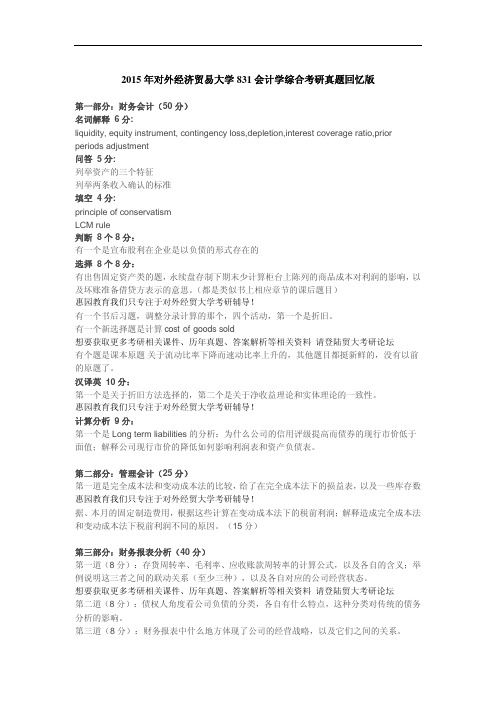
2015年对外经济贸易大学831会计学综合考研真题回忆版第一部分:财务会计(50分)名词解释6分:liquidity, equity instrument, contingency loss,depletion,interest coverage ratio,prior periods adjustment问答5分:列举资产的三个特征列举两条收入确认的标准填空4分:principle of conservatismLCM rule判断8个 8分:有一个是宣布股利在企业是以负债的形式存在的选择8个 8分:有出售固定资产类的题,永续盘存制下期末少计算柜台上陈列的商品成本对利润的影响,以及坏账准备借贷方表示的意思。
(都是类似书上相应章节的课后题目)惠园教育我们只专注于对外经贸大学考研辅导!有一个书后习题,调整分录计算的那个,四个活动,第一个是折旧。
有一个新选择题是计算cost of goods sold想要获取更多考研相关课件、历年真题、答案解析等相关资料请登陆贸大考研论坛有个题是课本原题关于流动比率下降而速动比率上升的,其他题目都挺新鲜的,没有以前的原题了。
汉译英 10分:第一个是关于折旧方法选择的,第二个是关于净收益理论和实体理论的一致性。
惠园教育我们只专注于对外经贸大学考研辅导!计算分析9分:第一个是Long term liabilities的分析:为什么公司的信用评级提高而债券的现行市价低于面值;解释公司现行市价的降低如何影响利润表和资产负债表。
第二部分:管理会计(25分)第一道是完全成本法和变动成本法的比较,给了在完全成本法下的损益表,以及一些库存数 惠园教育我们只专注于对外经贸大学考研辅导!据、本月的固定制造费用,根据这些计算在变动成本法下的税前利润;解释造成完全成本法和变动成本法下税前利润不同的原因。
(15分)第三部分:财务报表分析(40分)第一道(8分):存货周转率、毛利率、应收账款周转率的计算公式,以及各自的含义;举例说明这三者之间的联动关系(至少三种),以及各自对应的公司经营状态。
对外经贸大学会计学831考研管理会计讲义资料
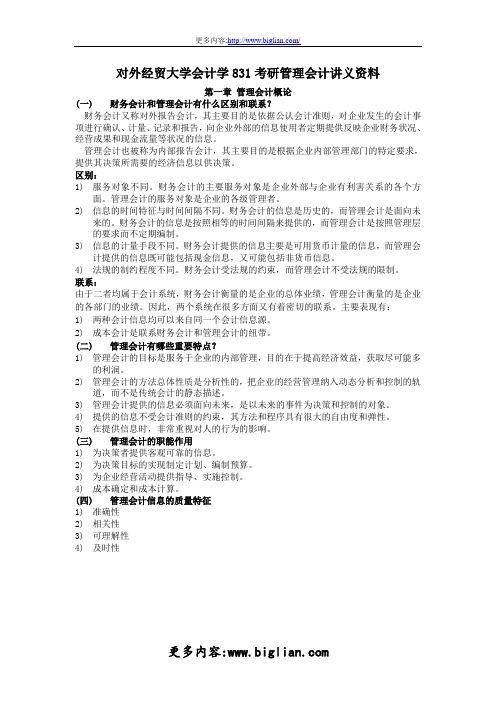
对外经贸大学会计学831考研管理会计讲义资料第一章管理会计概论(一)财务会计和管理会计有什么区别和联系?财务会计又称对外报告会计,其主要目的是依据公认会计准则,对企业发生的会计事项进行确认、计量、记录和报告,向企业外部的信息使用者定期提供反映企业财务状况、经营成果和现金流量等状况的信息。
管理会计也被称为内部报告会计,其主要目的是根据企业内部管理部门的特定要求,提供其决策所需要的经济信息以供决策。
区别:1)服务对象不同。
财务会计的主要服务对象是企业外部与企业有利害关系的各个方面。
管理会计的服务对象是企业的各级管理者。
2)信息的时间特征与时间间隔不同。
财务会计的信息是历史的,而管理会计是面向未来的。
财务会计的信息是按照相等的时间间隔来提供的,而管理会计是按照管理层的要求而不定期编制。
3)信息的计量手段不同。
财务会计提供的信息主要是可用货币计量的信息,而管理会计提供的信息既可能包括现金信息,又可能包括非货币信息。
4)法规的制约程度不同。
财务会计受法规的约束,而管理会计不受法规的限制。
联系:由于二者均属于会计系统,财务会计衡量的是企业的总体业绩,管理会计衡量的是企业的各部门的业绩。
因此,两个系统在很多方面又有着密切的联系。
主要表现有:1)两种会计信息均可以来自同一个会计信息源。
2)成本会计是联系财务会计和管理会计的纽带。
(二)管理会计有哪些重要特点?1)管理会计的目标是服务于企业的内部管理,目的在于提高经济效益,获取尽可能多的利润。
2)管理会计的方法总体性质是分析性的,把企业的经营管理纳入动态分析和控制的轨道,而不是传统会计的静态描述。
3)管理会计提供的信息必须面向未来,是以未来的事件为决策和控制的对象。
4)提供的信息不受会计准则的约束,其方法和程序具有很大的自由度和弹性。
5)在提供信息时,非常重视对人的行为的影响。
(三)管理会计的职能作用1)为决策者提供客观可靠的信息。
2)为决策目标的实现制定计划、编制预算。
会计专业英语复习资料

会计专业英语复习资料Post test 1 基本概念1. Things of value owned by an entity: assetsMoney: cashClaims of creditors: liabilitiesClaims of investors: equity2. 2 types of sources of funds:Stronger claim: liabilitiesLesser claim: equity3. A balance sheet reports the status of an entity ....at a point of time.4. Give the fundamental accounting equation: Assets = Liabilities + Equity5. The above equation is consistent with what concept?: Dual-aspect concept6. Money-measurement concept states that accounting reports only facts that can be expressed in monetary amounts.7. A balance sheet does not report all the facts about a business. What concept limits the amount or type of information that can be reported? Money-measurement concept8. Brown Company has 10000 dollar cash. Its owner withdraws 100 dollars for his own use. The owner is (no better or worse off) than he was before. Brown company now has (less) cash. The fact that this event affects the owner differently than it affects the company is an illustration of the entity concept.9. The entity concept states that accounts are kept for entities as distinguished from the persons who own those entities.11. The going-concern concept is: Accounting assumes that an entity will continue to operate indefinitely.12. The asset-measurement concept is: if reliable information is available, accounting focuses on the fair value of assets. Nonmonetary assets are reported at their original cost.13. An item can be reported as an asset if it passes 3 of the following: item is valuable, item was acquired at a measurable cost, item is owned or controlled by the entity.14. Goodwill is a favorable name or reputation purchased by the entity.15. An asset is classified as current if it is cash or is expected to be converted into cash in the near future, usually within one year.16. A liability is classified as current if it becomes due in the near future, usually within one year.17. Marketable securities are current assets. Investments are noncurrent assets.19. An insurance policy paid in advance of the time period covered is an example of a prepaid expense.20. A building, an item of equipment, and an automobile may all be examples of plant and property.21.Parker Company operates a furniture store. On December 31,2005,it had 30 desks that it was holding for sale. These would be reported as inventory. The desk that is used by the president of Parker Company would be reported as plant and property.22.Fox Company sold $1,000 of goods on credit to Golden Company. This would be recorded as an account receivable of Fox Company and as an account payable of Golden Company.23. Indicate whether the following statements about the balance sheet of a corporation are true or false:a. Assets list all the valuable things owned by the entity----Fb. The amount reported for the paid-in capital item isapproximately the fair value of the stock-----Fc. The amount reported for total equity is approximately the fair value of the corporation’s stock---Fd. Total equities (also called “net worth”) show approximately what the entity is worth.----Fe. Retained earnings is the amount of cash retained in the entity.-----FPost test 2 资产负债表的变更:收入的核算1.On January 2, John Brown started the Brown Company. In January, Brown Company did the following things:a. It received $5,000 cash from John Brown as its capital.b. It borrowed $10,000 from a bank, giving a note therefor.c. It purchased $4,000 of inventory for cash.d. It sold $2,000 of its inventory for $6,000 to a customer, who paid $3,500 cash and agreed to pay $2,500 within 30 days.e. It purchased an auto for $7,000. It paid $2,000 down and gave a note to the automobile dealer for the remaining $5,000f. Brown withdrew $1,000 cash for his personal use.g. Brown was offered $10,000 for his equity in the business, but he refused the offer.On a separate piece of paper, prepare a rough draft of a balance sheet for Brown Company as of the close to business January 31, and an income statement for January.Brown CompanyBalance Sheet as of Jan31AssetsCash……………………………………$11,500Accounts Receivable…………………2,500 Inventory………………………………….2,000 Automobile………………………………7,000Total………………………………………$23,000Liabilities and EquityNotes Payable………………………$15,000Paid-in Capital…………………………5,000Retained Earnings……………………3,000 Total……………………………………$23,000Brown CompanyIncome Statement for January Revenue...........................$6,000 Expense ...........................$2,000Income ............................$4,0002.Brown Company's income was $4,000, but its Retained Earnings was only $3,000. Reread the first frame and choose the item (a-g) that explains the difference. f3.John Brown claims that the inventory as of January 31 is worth $6,000, as shown by the fact that inventory costing $2,000 was actually sold for $6,000. Would you change the balance sheet ?...(No). This is an illustration of the asset-measurement concept. Nonmonetary assets are reported at their cost rather than their worth or fair value.Post test 3 会计记录和系统1. On March 5, Kay Company purchased $6,000 of inventory, paying cash.Prepare a journal entry for this transaction below.Journal2001 Transactions Dr. Cr.March 5Inventory6,000Cash6,0002. On March 10, Kay Company made a $15,000 sale to a customer who paid $6,000 cash and agreed to pay to the other $9,000 in 30 days. The merchandise sold had cost $8,000. Preparea journal entry for the sale, below.Journal2001 Transactions Dr. Cr.March 10Cash6,000Accounts Receivable9,000Revenues15,0003. On March 10, Kay Company made a sale for $15,000 for merchandise that had cost $8,000. Prepare a journal entry to record the cost of the sale below.Journal2001 Transactions Dr. Cr.March 10 Expenses8,000Inventory8,0004. Recall from the previous frames that revenues from the sale on March 10 were $15,000 and that the merchandise sold had cost $8,000. Prepare the closing entries.Journal2005 Transactions Dr. Cr.March 31Revenues15,000Retained earnings15,000March 31Retained earnings8,000Expenses8,0005-10. Omit11. A critic said that the company had $25,000 cash at the beginning ofMarch and $25,000 at the end of March, and since its cash balance was unchanged, it couldn't be said to have any income in March. This criticism is (incorrect).12. The reason the criticism is incorrect is because income is an increase inretained earnings, not necessarily in cash. For example, the sales revenue of Kay Company in March was $15,000 and its income was $7,000 even though $9,000 was received in cash.Post test 4 营业收入和货币资产1. The conservation concept states that increases in equity are recognized only when they are reasonably certain, while decreases in equity are recognized as soon as they are reasonably possible.2. The materiality concept states: disregard trivial matters but disclose all important matters.3. What is the length of the usual accounting period? One year. Financial statements prepared for shorter periods are called interim statements.4. Cash accounting reports items that increase or decrease cash. Accrual accounting reports items that change equity or retained earnings, even though these changes may not affect cash.5. Increases in equity associated with the entity’s operations during a periodare revenues, and decreases are expenses. The difference between them is labeled income.6. The realization concept states that revenues are recognized when goods or services are delivered.7. H Company manufactures a table in August and places it in its retail store in September. R Smith, a customer, agrees to buy the table in October, it is delivered to him in November, and he pays the bill in December. In what month is the revenue is recognized? (November)8. The receipt of cash is a debit to Cash. What is the offsetting credit and (type of account) for the following types of salestransactions?Account Crediteda. Cash received prior to delivery. Advances from customers(a liability)b. Cash received in same period as delivery. Revenuec. Cash received after the period of delivery. Accounts receivable (an asset)9. Similarly, revenue is a credit entry. What is the offsetting debit whenrevenue is recognized in each of these periods?Account Debiteda. Revenue recognized prior to receipt of cash. Accounts receivableb. Revenue recognized in same period as receipt of cash. Cashc. Revenue recognized in the period following receipt of cash. Advances from customers10. In February, H Company agrees to sell a table to a customer for $600,and the customer makes a down payment of $100 at that time. The cost of the table is $400. The table is delivered to the customer in March, and the customer pays the remaining $500 in April. Give the journal entries (if any) that would be made in February, March, and April for both the revenue and expense aspects of this transaction. February:Cash100Advances from customers100March:Accounts receivable500Advances from customers100Revenue600March:Expenses400Inventory400April:Cash500Accounts receivable50011. At the end of 2005, M Company had accounts receivable of $200,000,and it estimated that $2,000 of this amount was a bad debt. Its revenue in 2005, with no allowance for the bad debts, was $600,000.A. What account should be debited for the $2,000 bad debt? RevenueB. What account should be credited? Allowance for doubtful accountsC. What amount would be reported as net accounts receivable on the balance sheet? $198,000D. What amount would be reported as revenue on the 2005 income statement? $598,00012. In 2006, the $2,000 of bad debt was written off.A. What account should be debited for this written off? Allowance for doubtful accountsB. What account should be credited? Accounts receivablePost test 5 费用的核算;损益表1. An expenditure occurs in the period in which goods or services are acquired. An expense occurs in the period in which goods or services are consumed.2. A certain asset was acquired in May. There was therefore an expenditure in May. At the end of May, the item was either onhand, or it was not. If it was on hand, it was an asset; If it was not on hand, it was an expense in May.3. Productive assets are unexpired costs. Expenses are expired costs.4. The matching concept states that costs associated with the revenues of a period are expenses of that period.5. Expenses of a period consist of:a. costs of the goods and services delivered during that period.b. other expenditures that benefit operations of the period.c. losses6. If Brown company pays rent prior to the period that the rent covers, the amount is initially reported as credit to cash and a debit to Prepaid Rent, which is an asset account. If Brown Company pays the rent after the period covered, the amount is initially recorded as a debit to Rent Expense and a credit to Accrued Rent, which is a liability account.7. A brand new machine owned by Fay Company was destroyed by fire in 2005. It was uninsured. It has been purchased for $10,000 with the expectation that it would be useful for 5 years. The expense recorded in 2005 should be $10,000.8. Gross margin is the difference between sales revenue and cost of sales.9. gross margin percentage: (gross margin)/(sales revenue)10. The difference between revenues and expenses in an accounting period (or the amount by which equity [i.e., retained earnings] increased from operating activities during the period) is called net income.11. A distribution of earnings to shareholders is called dividends(股利).12. retained earnings at the end of the period= retained earnings at the beginning of the period + net income – dividends.Post test 6 存货和销售成本1. A dealer sells a television set for $800 cash. It had cost $600. Write journal entries for the four accounts affected by this transaction.Dr. Cash800Cr. Revenue800Dr. Cost of Sales600Cr. Inventory6002. When using the perpetual inventory method (永续盘存), a record is kept for each item, showing receipts, issues, and the amount on hand.3. Write an equation that shows how the cost of sales is determined by deduction:Cost of sales = beginning inventory + purchases – ending inventory4. Omit5. In periods of inflation, many companies use the LIFO method incalculating their taxable income because LIFO gives a higher cost of sales and hence a lower taxable income.6. A company discovers that the fair value of its inventory is $1000 lower than its cost. What journal entry should it take?Dr. Cost of Sales1,000Cr. Inventory1,0007. In a manufacturing business, what three elements enter into the cost of a manufactured item?Direct material, direct labor, and overhead.8. Period costs become an expense during the period inwhich they were incurred.9. Product costs become an expense during the period in which the products were sold.10. One type of overhead rate involves use of the total direct labor costs and total production overhead costs for a period. Write a ratio that shows how the overhead rate is calculated.(Total production overhead costs)/(Total direct labor costs)11. A given finished item requires $50 of direct materials and 5 hours of direct labor at $8 per hour. The overhead rate is $4 per direct labor hour. At what amount would the finished item be shown in inventory? $110= 50+ 40 + 2012. An inventory turnover of 5 is generally better than an inventory turnover of 4 because it indicates that less capital is tied up in inventory, and there is less risk that the inventory will become obsolete.Post test 7 非流动资产和折旧1. The amount at which a new plant asset is recorded in the accounts includes its purchase price plus all costs incurred to make the asset ready for its intended use (such as transportation and installation).2. A plant asset is acquired in 2005. It is expected to be worn out at the end of 10 years and to become obsolete in five years. What is its service life? ---Five years.3. Ordinarily, land is not depreciated because its service life is indefinitely long.4.A plant asset is acquired in 2005 at a cost of $20000. Its estimated service life is 10 years, and its estimated residual value is $2000 :a. The estimated depreciable cost of the asset is $18,000b. If the straight-line depreciation method is used, thedepreciation rate for this asset is 10 percent.c. What amount will be recorded as depreciation expense in each year of the asset’s life?---$1,800d. What amount will be debited and what account will be credited to record this depreciation expense?Dr. Depreciation expenseCr. Accumulated depreciatione. After five years have elapsed, how would this asset be reported on the balance sheet?1) Plant------$20,0002) Less accumulated depreciation-------$9,0003) Book value-------$11,0005. A machine is purchase on January 2, 2005, for $20,000 and its has an expected life of five years and no estimated residual value.a. If the a machine is still in use six years later, what amount of depreciation expense will be reported in for the sixth year?----zerob. What amount, if any, will be reported on the balance sheet at the end of the sixth year?1) It will not be reported.-----X2) It will be reported as follows:Machine $20,000Accumulated depreciation $20,000Book value $06. A machine is purchase on January 2, 2005, for $50,000. It has an expected service life for 10 years and no residual value. Eleven years later it is sold for $3,000 cash.a. There will be a gain of $3,000b. What account will be debited and what account creditedto record this amount?Dr. CashCr. Gain on disposition of assets.7. Given an example of each of the following types of assets, and give the name of the process used in writing off the cost of the second and third type.Asset type\Example\Write-off processPlant Asset\m achine, b uilding\DepreciationWasting asset\c oal, o il ,m inerals\DepletionIntangible asset\g oodwill, t rademark \Amortization8. Conoil Company purchased a producing oil property for $10,000,000 on January 2, 2005. It estimated that the property contained one million barrels of oil and that the property had a service life of 20 years. In 2005, 40,000 barrels of oil were recovered from the property. What amount should be charged as an expense in 2005?------$400,0009. Wasting assets and intangible assets are reported on the balance sheet ina different way than building, equipment, and similar plant assets. The difference is that wasting assets are reported at the net amount and plant assets are reported at cost, accumulated depreciation, and net amount. 10. In calculating its taxable income, a company tries to report its income as low as it can. In calculating its financial accounting income, a company tries to report its income as fairly as it can.11. As compared with straight-line depreciation, accelerated depreciation writes off more depreciation in the early years of an asset’s life and less in the later years. Over the whole life of asset, accelerated depreciation writes off the same total cost as straight-line depreciation.12. Companies usually use accelerated depreciation in tax accounting because it reduces taxable income and hence income tax in the early years.13. Assume an income tax rate of 40%. If a company calculated its financial accounting income (before income taxes) in 2005 as $6 million and its taxable income as$4 million, what amount would it report as income tax expense on its 2005 income statement?----$2,400,00014. Fill in the missing name on the following table:Income tax expense $100,000Income tax paid -60,000Deferred income tax $ 40,000The $40,000 would be reported on the balance sheet as a liability.。
- 1、下载文档前请自行甄别文档内容的完整性,平台不提供额外的编辑、内容补充、找答案等附加服务。
- 2、"仅部分预览"的文档,不可在线预览部分如存在完整性等问题,可反馈申请退款(可完整预览的文档不适用该条件!)。
- 3、如文档侵犯您的权益,请联系客服反馈,我们会尽快为您处理(人工客服工作时间:9:00-18:30)。
Chapter2BASIC FINANCIAL STATEMENTS
financial statements掌握以下
1)A financial statement is simply a declaration of what is believed to be true about an enterprise, communicated in terms of a monetary unit,such as the dollar.
一张报表就是对认为真实的事情的陈述。
会计人员在编制财务报表时,就是以财务语言描述企业的一些特征,他们认为这些特征公允地反映了企业的财务活动。
2)The statement of financial position,or balance sheet,is a financial statement that describes where the enterprise stands at a specific date.It is sometimes described as a snapshot of the business in financial or dollar terms(that is what the enterprise“looks like”at a specific date).财务状况表或资产负债表:是描述企业在某一特定时点状况的财务报表,它有时被称为用财务或货币语言表述的企业“快照”(即企业在某一特定时点的“相貌”)。
3)An income statement is an activity statement that depicts the revenue and expenses for a designated period of time.损益表是一张描述某一时期收入和费用的活动表。
4)The statement of cash flows is particularly important in understanding an enterprise for purposes of investment and credit decisions.The statement of cash flows depicts the ways cash changed during a designated period—the cash received from revenues and other transactions as well as the cash paid for certain expenses and other acquisitions during the period.现金流量表对于为了投资和信贷决策而了解企业尤为重要。
正如其名称所暗示的,现金流量表描述了现金在某一特定时期的变化方式—在该期间从收入和其他业务中取得的现金以及为某些费用和其他所购物品而支付的现金。
statement of financial position(此处可以出question题)
1)The Concept of the Business Entity:
GAAP require that a set of financial statements describes the affairs of a specific economic entity. This concept is called the entity principle.
A business entity is an economic unit that engages in identifiable business activities.For accounting purposes,the business entity is regarded as separate from the personal activities of its owners.(以前常出大家应以掌握好了)
Assets are economic resources that are owned by the business and are expected to provide positive future cash flows.cost principle of accounting.
2)The going-concern assumption:
The balance sheet of a business is prepared on the assumption that the business is a continuing enterprise,or a going concern.Determine that an enterprise is a going concern may require judgment by the accountant.
3)The objectivity principle:
Accountants use the term objective to describe asset valuations that are factual and can be verified by independent experts.
4)The stable-dollar assumption
以下应至少会用自己的话陈述
Liabilities:
Notes payable
Account Payable(应付账款)
Accrued(应计)expense
Owners’equity
Capital stock(实收资本)
Retain earning(留存收益)
The accounting equation:。
